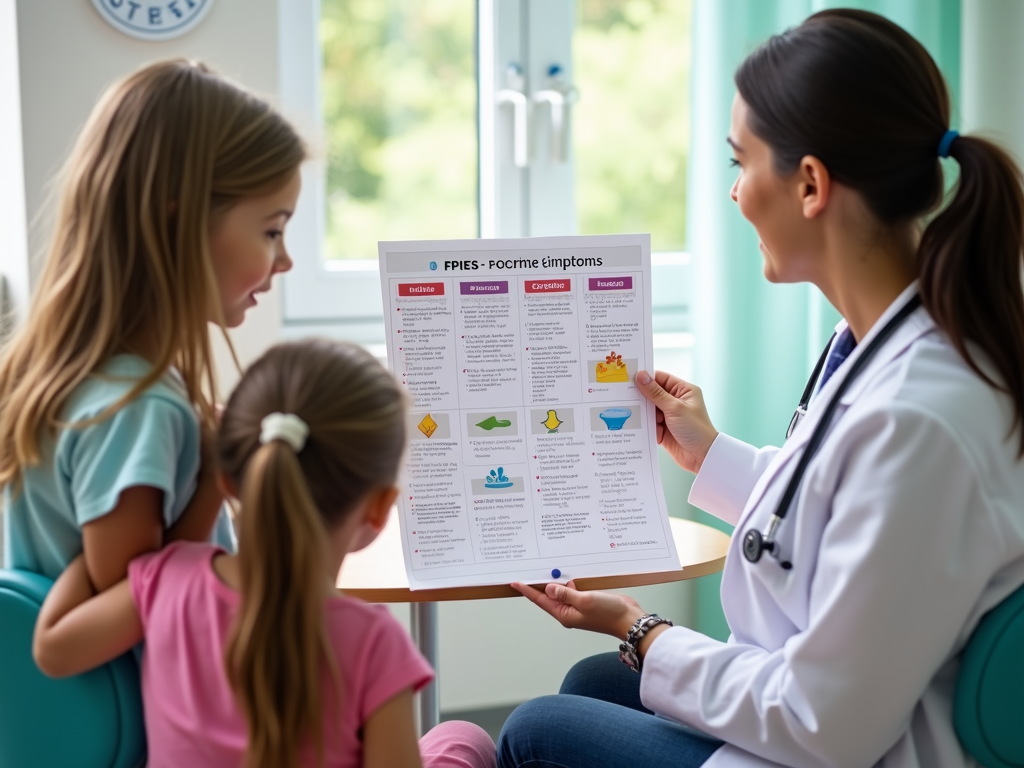Food allergies in children can turn mealtime into a challenge for parents. Knowing what they are, how they impact your child, and how to handle them is key. This guide dives deep into understanding food allergies in children, with a special focus on chronic FPIES, offering clarity and support.

What Are Food Allergies?
Food allergies happen when a child’s immune system mistakes a food for a threat. It fights back, causing reactions like rashes, swelling, or even breathing trouble. Common culprits include peanuts, milk, eggs, and shellfish. According to the American Academy of Allergy, Asthma & Immunology, about 8% of kids in the U.S. have food allergies.
Don’t confuse allergies with intolerances. Allergies trigger the immune system; intolerances mess with digestion. For instance, a milk allergy might cause hives, while lactose intolerance leads to bloating. Knowing the difference helps you act fast and right.
How Food Allergies Affect Kids
Allergies can hit kids hard. Mild reactions might mean itchy skin or a runny nose. Severe ones, like anaphylaxis, can close airways and need instant care. Every child’s different—some outgrow allergies, others don’t. The National Institute of Allergy and Infectious Diseases says early exposure to allergens might prevent some cases, but once they start, they change daily life.
Think about birthday parties or school lunches. Kids with allergies face limits others don’t. As a parent, I’ve seen the worry in my son’s eyes when he couldn’t share cake with friends. It’s tough, but manageable with the right steps.

What Is Chronic FPIES?
Chronic FPIES (Food Protein-Induced Enterocolitis Syndrome) is a rare food allergy affecting the gut. Unlike typical allergies, it doesn’t cause instant hives or swelling. Instead, hours after eating a trigger food—like rice, oats, or milk—a child might vomit repeatedly, turn pale, or seem exhausted. With chronic FPIES, regular exposure keeps symptoms going, stunting growth or causing weight loss.
It’s tricky to spot. Symptoms look like stomach bugs or other issues. Doctors often use food elimination trials to figure it out. Personal note: Watching my niece struggle with undiagnosed FPIES was heartbreaking—until we found the trigger, every meal felt like a gamble.
Diagnosing Chronic FPIES
Diagnosing chronic FPIES takes patience. There’s no simple test. Doctors rely on your child’s history—when symptoms start, what they ate, how long it lasts. They might suggest cutting out suspect foods, then reintroducing them under supervision. The Children’s Hospital of Philadelphia explains that this process can take weeks but is worth it for answers.
Tip: Keep a food diary. Write down what your child eats and how they react. It helped us pinpoint my niece’s oat issue. Share it with your doctor—it’s gold for diagnosis.

Managing Food Allergies and FPIES
Handling food allergies means staying proactive. Here’s what works:
- Avoid Triggers: Check labels every time. Even ‘safe’ foods can hide allergens.
- Plan Ahead: Pack allergy-friendly snacks for outings.
- Emergency Prep: Carry epinephrine if your doctor prescribes it—seconds count in anaphylaxis.
- Team Up: Tell teachers, friends, and family about your child’s needs.
For chronic FPIES, it’s stricter. You might need hypoallergenic formulas or dietitian help. I learned this with my niece—swapping foods felt like a science experiment, but it paid off when she started thriving.
Emotional Side of Allergies
Food allergies don’t just hit the body—they affect the heart, too. Kids might feel isolated at pizza parties or scared of mistakes. My son once cried because he couldn’t eat what his cousins did. It’s normal for them to feel different.
What helps?
- Talk It Out: Ask how they feel and listen.
- Make It Fun: Find tasty substitutes they love.
- Boost Confidence: Teach them to speak up about their allergies.
Over time, my son went from shy to proud of managing his limits. It’s a journey, but they grow stronger.

Common Triggers and Stats
Here’s a quick look at top allergens and their impact:
| Food | % of Kids Affected | Common Reaction |
|---|---|---|
| Peanuts | 2.5% | Hives, anaphylaxis |
| Milk | 2.0% | Vomiting, rash |
| Eggs | 1.5% | Itching, swelling |
| Shellfish | 1.0% | Breathing issues |
Data from the Food Allergy Research & Education (FARE) shows these numbers are rising. Why? Experts think modern diets and less early exposure play a role. For FPIES, triggers vary—milk and grains top the list.
Tips for New Parents
Just starting out? Don’t panic. Here’s what I wish I’d known:
- Start Small: Introduce one food at a time to spot reactions.
- Trust Your Gut: If something feels off, see a doctor.
- Build a Network: Other parents get it—swap stories and tricks.
When my son’s allergy hit, I felt lost. A friend suggested an allergist, and it changed everything. You’ll find your rhythm, too.

Working with Doctors
A good allergist is your partner. They’ll test, advise, and guide. For FPIES, they might team up with a gastroenterologist. Ask questions—What’s the plan? Are there new treatments? The more you know, the better you manage.
Personal take: Our doctor’s calm explanations turned chaos into control. Finding one who listens is half the battle.
School and Social Life
School’s a big test for allergies. Meet with staff—share a care plan. Pack safe lunches. For FPIES, explain delayed reactions; they’re less obvious. Socially, coach your child to say no politely. My son’s teacher once called him brave for it—small wins matter.

Summary
Understanding food allergies in children, including chronic FPIES, equips you to protect your child. From spotting symptoms to dodging triggers, this guide covers it all. You’ve got this—knowledge, preparation, and support make a healthy life possible. Check out more resources below to keep learning.
Discuss Here